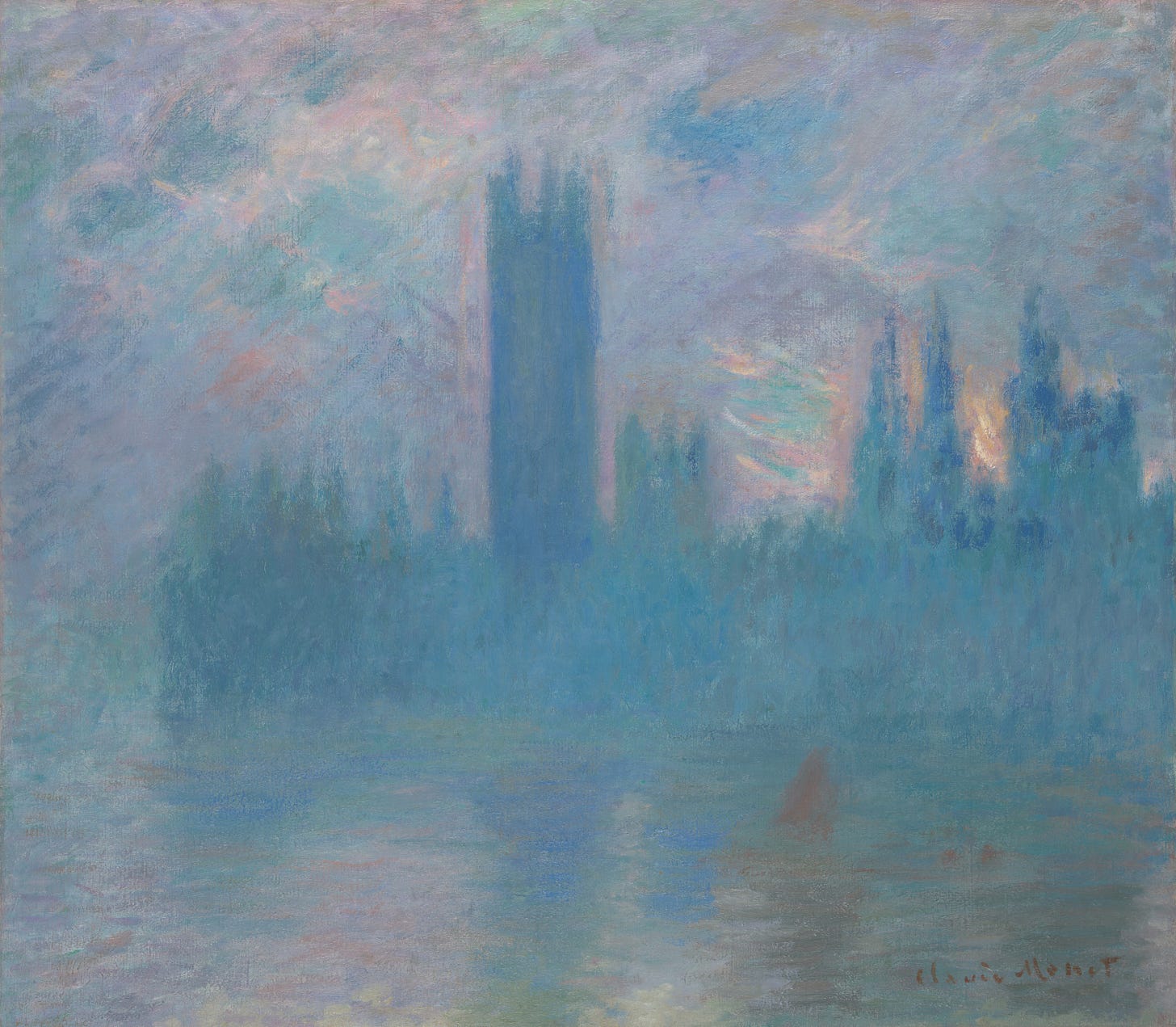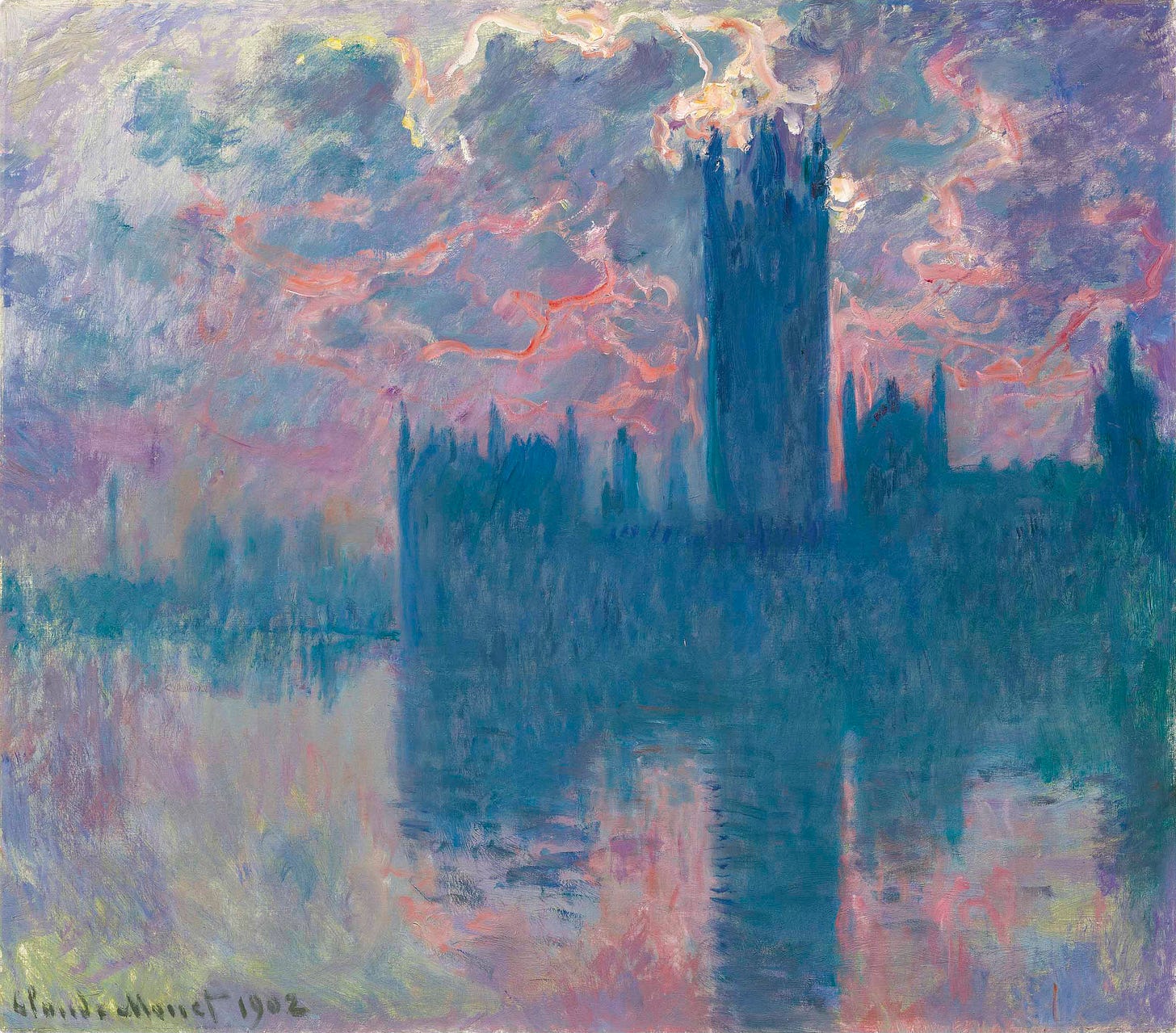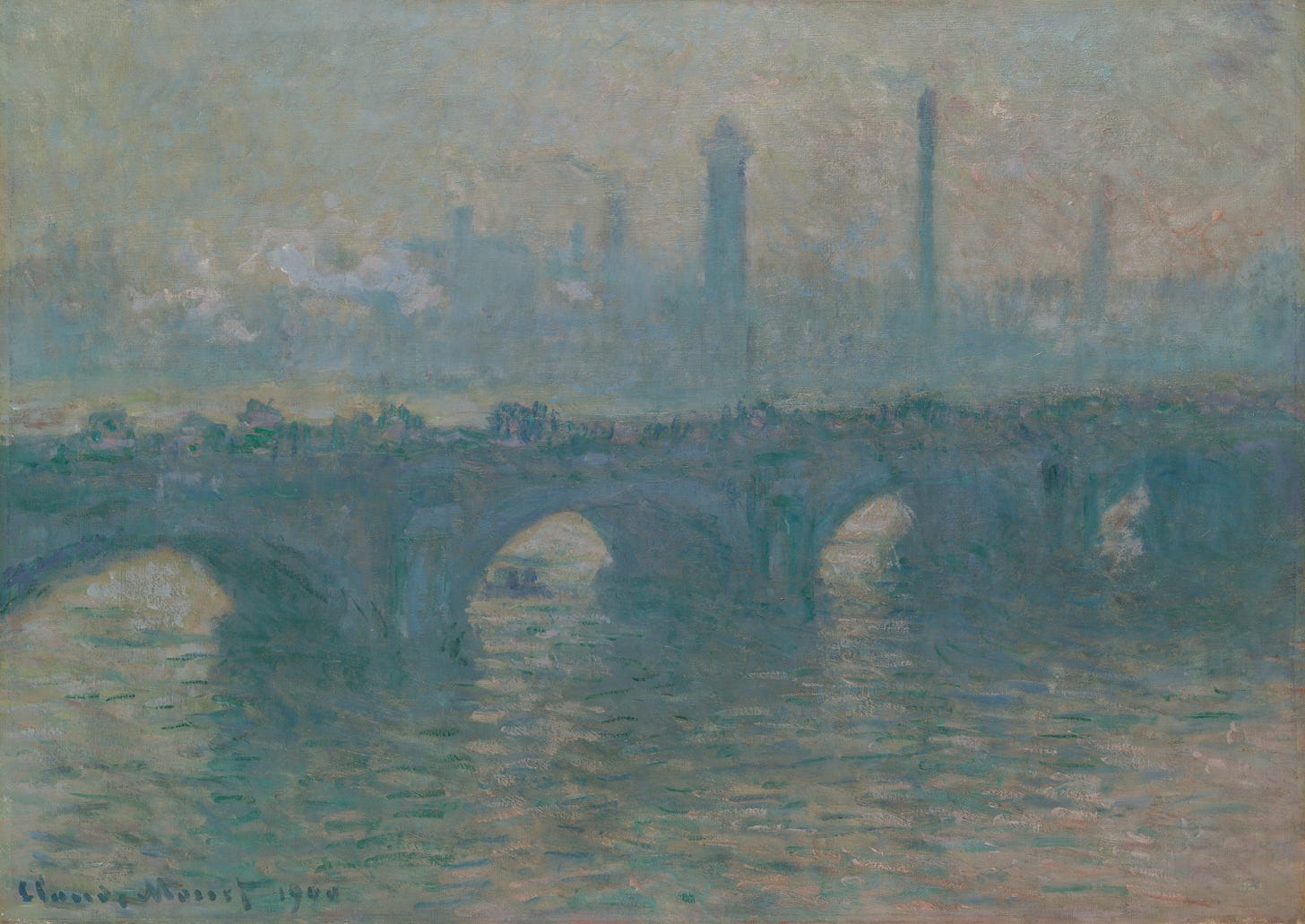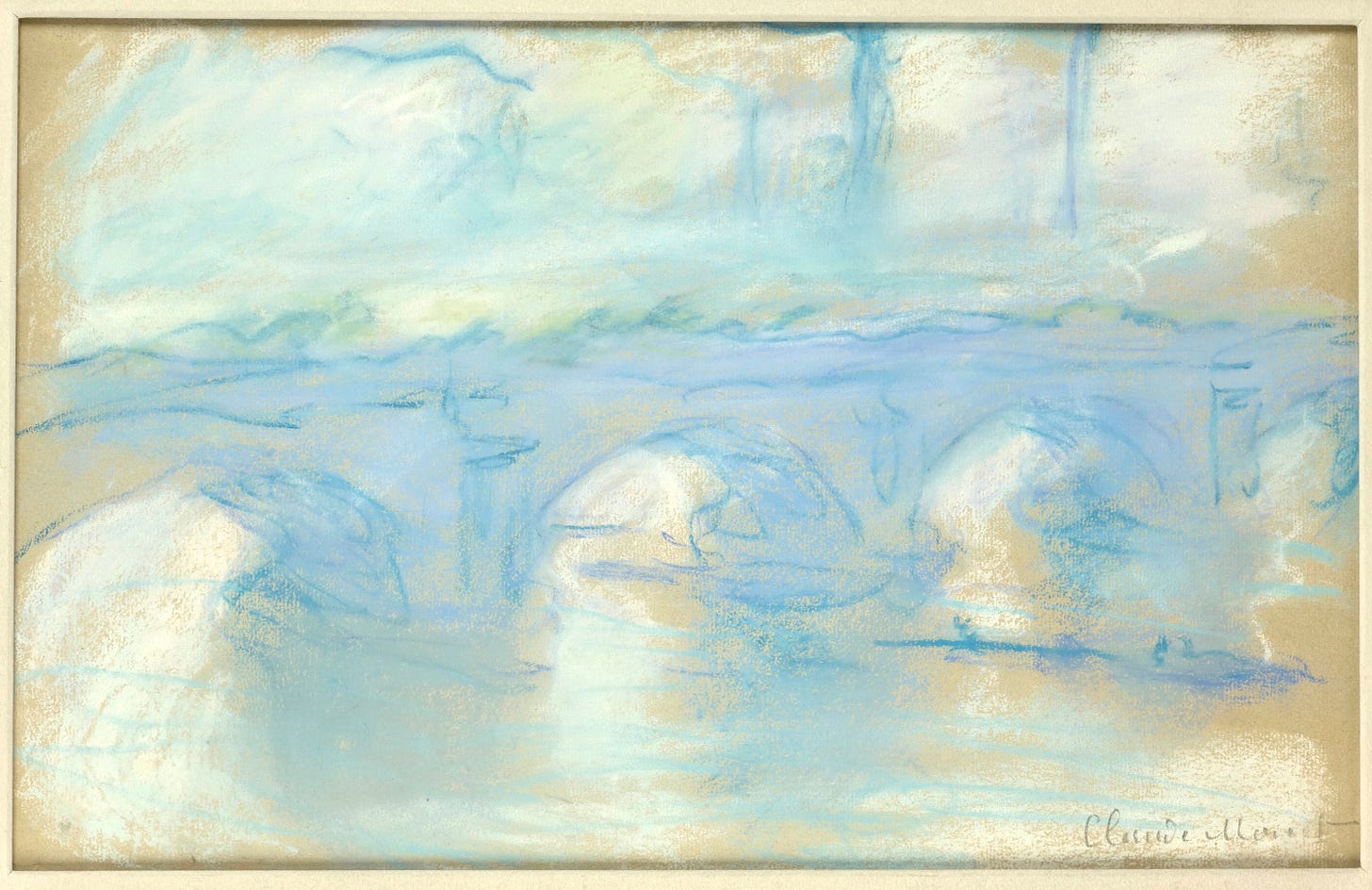Claude Monet: Painting the London Series
“This morning at dawn there was an extraordinary fog, completely yellow. I made an impression of it, I think - it’s always beautiful, but it's also so changeable that I had to start a lot of paintings of the Waterloo Bridge and the Parliament. I also took back several paintings from the first trip, some not so good ones. It's also here that I'm working the most so far, going to the hospital only at 4pm. Alas the fog won't lift and I'm afraid I'll lose my morning…But there he is, showing his face the sun.”1
Claude Monet wrote this to his wife in 1900, on one of his painting trips to London. This short excerpt captures the energy and tension that characterized Monet’s painting sessions in London, as well as his habit of working on multiple paintings at once. Thanks to the fact that Monet’s wife stayed in France on these trips and they corresponded regularly, we have excellent documentation on Monet’s working methods, thoughts, and state of mind while he was painting this series. It’s a fascinating glimpse into the process that went into the enormous undertaking that was the London series.
For some reason, although I have enjoyed the work of Monet for years, I wasn’t really aware of his London paintings until recently, and I found them rather startling at first. Probably because I so associate him with countryside subjects rather than cityscapes. And yet Monet found London a compelling subject, spending months working there on-location and completing approximately one hundred paintings of it altogether.
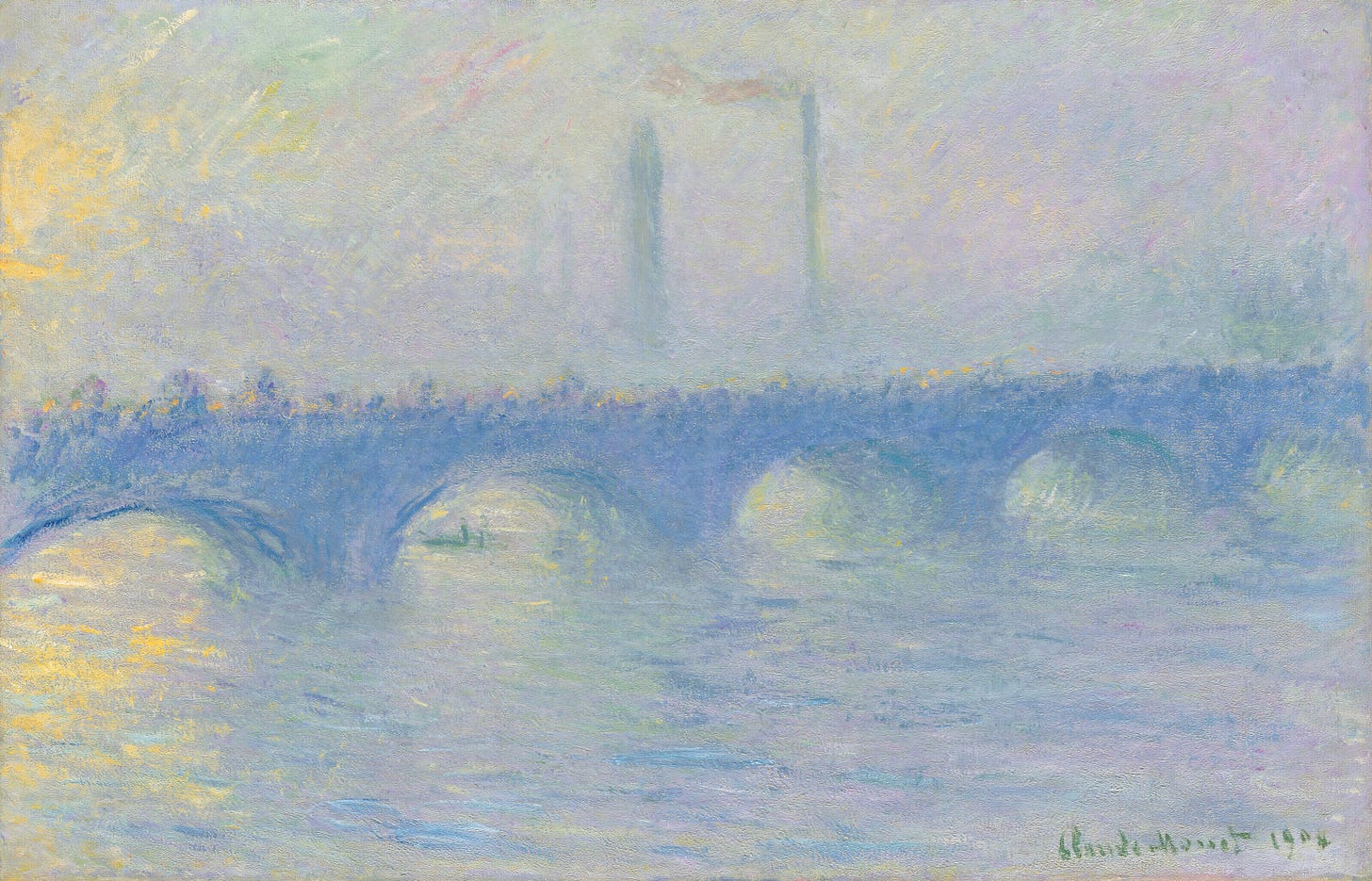
Although Monet and London seem at first a surprising combination, it makes sense when you learn that Monet was fascinated by London’s unique atmospheric effects, produced by both natural fogs and man-made pollution. This haze, and the way the many river views would shift in and out of focus in it, fascinated him. After visiting London for the first time in his twenties, before he became known as an impressionist, Monet thought of returning for a serious painting trip for decades. It finally happened in 1899, when he was almost sixty, spurred on by his son’s decision to go to London to study and by the urging of English painter friends such as J.M. Whistler and John Singer Sargent.
If you look at the London paintings, there are just three views that he painted over and over: the Houses of Parliament as seen over the Thames, Waterloo Bridge, and Charing Cross Bridge. The reason for this (aside from the fact that he had a fascination with studying the same subject under varying light conditions) is the fact that he was working from just two vantage points: a fifth-floor room in the Savoy Hotel and a terrace at the newly built St. Thomas’ Hospital. The room at the Savoy had the two views of the bridges, while at the Hospital Monet caught the view of the Parliament buildings, nicely backlit at sunset.
On this first trip to London in the late fall of 1899, Monet spent over a month at his rooms in his rooms at the Savoy, but it was just the start of his ‘campaign’, as he called painting trips. He was not satisfied with any of his painting starts – eleven are recorded – and he returned a few months later in January of 1900. Winter was the best time to take advantage of London’s fogs and since he was working indoors at the Savoy, it was not in the least inconvenient. Even at the age of sixty, Monet was a warhorse for work. He would rise at 6 and work out of his window at the Savoy, switching between views of first one bridge and then the other, until around 4 pm, when he would rush across the river to the the Hospital to catch the afternoon and sunset effects over the houses of Parliament. His work process sounds both focussed and chaotic. He was disciplined with his schedule, working on each separate ‘effect’ as it showed up, and heading over to the hospital promptly each afternoon no matter how well work was going at the Savoy. And yet because of the multifarious combinations of fog, smog, sunlight and cloud, each day was slightly different, and he would make a new start each time he saw a new ‘effect’. The half-finished canvases started to pile up until by the end of his trip they numbered something between sixty-five and eighty – although he did seem to manage to keep in his mind which canvas took place at which time of day and he would pull each out as that light effect returned, watching out the window like a hawk. Not surprisingly, under this method Monet frequently expressed both exhaustion and frustration.
He did manage to make time in his schedule for socializing, mostly after daylight had ended for the day. Particularly with John Singer Sargent, a sociable fellow who had a warm regard for Monet and was, in fact, the person responsible for helping him get permission to paint at St. Thomas’ Hospital. Sargent, who had a more phlegmatic disposition than his French friend, humorously recalled a visit to Monet at the Savoy during working hours:“…he found him surrounded by some ninety canvases — each one the record of a momentary effect of light over the Thames. When the effect was repeated and an opportunity occurred for finishing the picture, the effect had generally passed away before the particular canvas could be found.”2
Monet spent all of the early spring of 1900 in London; however, by April the weather and the position of the sun in the sky had changed too much for him to continue working on those canvases he had started two months prior. And besides he was exhausted from his scattered efforts, and particularly the need to continually rework canvases already started. He packed up his canvases and returned home to Giverny, having racked up (not surprisingly!) a ‘terrible bill’ at his London art supplier’s. 3
Always emotional about his work, his general mood at this time was one of defeat: he wrote to his dealer Durand-Ruel, who was inquiring about new work,
“I am going through a period of great discouragement, so this is not the right moment for you to come, even though I have done nothing but work since I returned from London. But I am incapable of finishing anything as I should like…It is not that I haven’t been working hard, but as I am getting slower and more demanding, I haven’t been able to achieve what I wanted.” 4
Monet spent the summer of 1900 at Giverny working on, and painting in, his garden. But the unfinished London canvases were on his mind, and he returned to his room at the Savoy in January of 1901, shipping all of his unfinished canvases back to London as well. He again worked from the rooms at the Savoy in the morning and at St. Thomas’ Hospital in the afternoon, but he now limited himself to a smaller number of canvases to work on simultaneously, which seems to have helped control the chaos. He was able to make considerable progress on already-started paintings as well as some new ones, but at the end of his 1901 trip he was still unsatisfied with the results, complaining:
“This is not a country where you can finish a picture on the spot; the effects never reappear. I should have made just sketches, real impressions. With that and some drawings I could have made something of it, whereas instead I have reworked some canvases as many as twenty times, spoiling them as I went, and ending up redoing them as a sketch anyway in double-quick time.”5
As a matter of fact, this is what he ended up doing. Not satisfied that his London paintings were ‘finished’ according to his standards, he took the entire collection of paintings back to his studio at Giverny and kept them there for the next two years, refusing to sell any of them until all were done. He did not return to London but continued to work on the London views in his Giverny studio over the course of 1902 and 1903, in between plein air sessions of water lilies. He worked mostly from his memory, using using the completed ones as visual reference for the ones he was still refining. (He did ask John Singer Sargent to send him a single photograph of the buildings of Parliament as a reference, scandalizing those fans who were convinced he only painted in plein-air. Monet did prefer painting on the spot, but would do whatever it took to complete a painting, including working from the studio. His response to this criticism was irritable but to-the-point. “Whether my Cathedrals, my London pictures and all the others are painted from nature or not, is of no significance and is nobody’s business but mine.”6)
This working process perhaps helps explain why the completed ‘Views of London’ all feel so harmonious together – he slowly developed these paintings as a group over the course of four years, with finishing touches from a memory-sifted visual hierarchy. Monet, who was anxious to make some sales after investing four years and massive amounts of paint into the series, finally called it done in 1904. He exhibited thirty-six views of London at his dealer Durand-Ruel’s Paris gallery in May of 1904, to great public acclaim and (to his delight) the sale of twenty-four paintings.
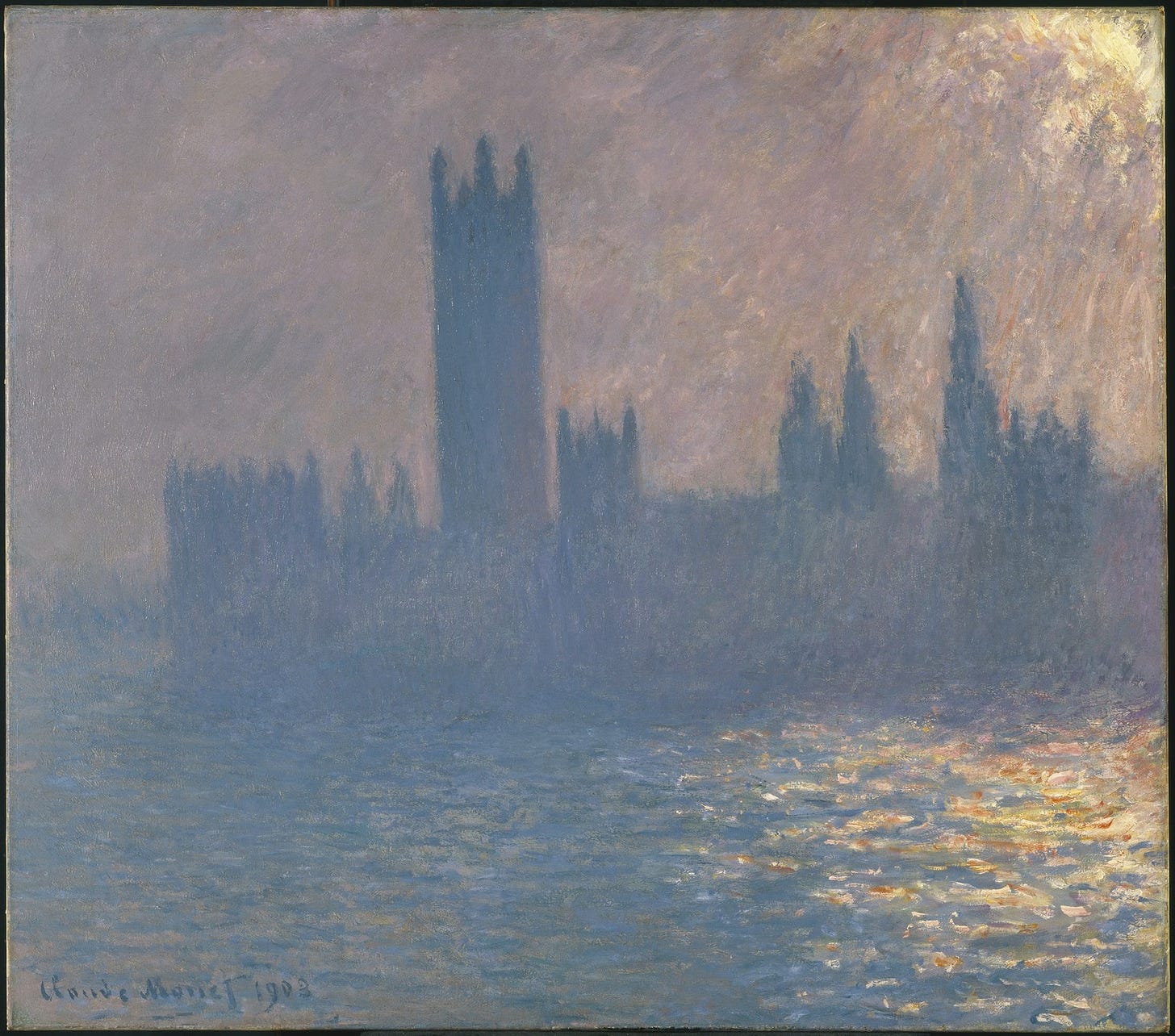
From John Sargent by Evan Charteris
Monet: or the Triumph of Impressionism by Daniel Wildenstein, pg. 345
Ibid., pg 352
Ibid., pg 354
Ibid., pg 372




